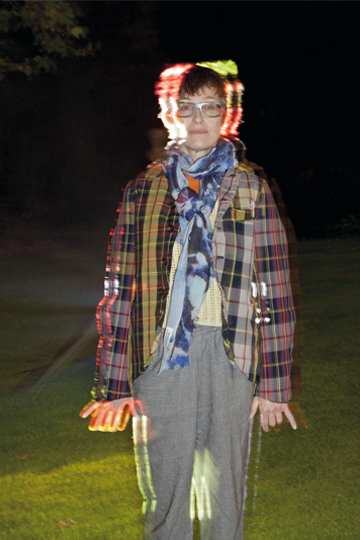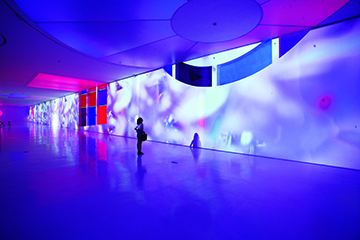PIPILOTTI RIST
| December 20, 2013 | Post In LEAP 24

For her first solo exhibition in China, Pipilotti Rist created several new works for the Times Museum in Guangzhou and the surrounding community. These included a series of lanterns made of recycled materials from the residential complex below, the 30-meter-long video installation Mercy Mercy, a humorous chandelier made of underwear, and brightly colored videos that turned the spaces into something of an amusement park. For one work, Rist painted one of the museum’s glass rooms red, and projected her new video Open Air (A la belle étoile) on the middle of the floor. Apparently, Guangzhou is red in her eyes. Having yet to visit Beijing, during our interview she inquired: “What color is Beijing?” Our answer was gray, a northern Chinese gray born of smog and pollution that she might not be able to imagine. In Rist’s work the people are sprightly, relaxed, and happy, engulfed in gloriously colorful palettes. Just like the artist’s personality, they face the world full of innocent curiosity.
LEAP Were most of the works in this exhibition made in Guangzhou?
Pipilotti Rist The sculpture work was made in Guangzhou. The big video work was shot in England but also prepared here in Guangzhou. I wanted to make it site-specific and use the unusually big room here in the museum. I wanted viewers to think about time and movement— time related to space. I wanted to take them away from fixed positions. You have to walk around to see it.
LEAP How does your work strive to affect our spatiotemporal experience?
PR My main material is usually light, and only moving light. Most cultural expressions today, like music and film, can be experienced in the private space. But when viewers come to the museum, they come with their bodies. I want to engage their bodies and I hope they go out feeling like they’ve got something new, that their own problems have become relative. Everyone has their own problems in life, but when we watch culture together in one room, our own problems become relative. The museum is like a collective living room for all the people who come here. Normally people have a reason, like a commercial reason, to come together, but there’s no reason to come together here except for contemplation and the attempt to know if others feel the same. There’s no furniture in the room because people will just sit instead of moving around. I want the kids to be running around. I don’t know how people will react with their body, but the body of the spectator is part of the work. This is an old theory, but only with the audience can art and culture be fulfilled.
LEAP What do you want to achieve in these works?
PR I have different agendas for different works, different wishes to be fulfilled. I’m interested in glorifying the imperfect. I’m more interested in the surface of a plant than the surface of a Porsche. We are afraid of the chaotic because it implies death, which is why people prefer the fake, glossy, symmetrical perfection of a Porsche. I’m interested in the organic, chaotic structure of beauty. I’m not afraid of beauty, although it is often associated with corruption, because beauty is also exploited to sell things, like the whole business of advertisement. The human psyche needs its own definition of beauty for the relaxation of minds. There are beauties other than what advertisement employs.

LEAP How do you manage to use the very logical medium of video to reflect a world of chaos?
PR I want to find beauty in the chaos, but it doesn’t mean that I accept everything. It’s true that the electronic medium is absolutely not chaotic, but very systematic. My goal is that the work becomes invisible when it really flows and makes perfect sense. In the end, the more work you put in, the less you see the work. It’s just like drinking tea—you taste the concentrated time in old tea. Thousands of hours might have been put into a work of cultural expression, but at the moment of consumption, you get all this time as a gift. I usually spend half a year on a single work, and it can always be improved. If I show a work a second time, I always revise it based on different sites.
Today, with computers, TVs, and mobile phones, everything is flat and put behind glass—our feelings, histories, longings. We’re all separated from each other, for the human being we are in contact with is always behind a glass. Of course our skin is also a border that separates us from others. We can feel the skin even during sex. But when we listen to music together, go to an exhibition or have a discussion about art, we can jump out of our loneliness. We make music and art in an attempt to understand each other better, to be together in a bubble, beyond words. Sometimes I succeed, sometimes I fail. I succeed the moment when people come to me and say that they are touched, that they’re reminded of something or are reflecting on themselves.
LEAP What are your expectations for your public works, which are sometimes mistaken as advertisements? Do you think there’s any difference between your work and advertisement?
PR People today don’t look at advertisements anymore. They say that they are everywhere, but I have the feeling that they don’t look at them at all. The difference is that when people come to a museum, they have to take time. People used to visit temples to have a moment of reflection on subjects outside of their daily hassle. In a less religious age, museums sometimes perform the same function. There is a difference between works exhibited in a museum and in public space. The form of video is not good for public spaces, because if something is moving, people can’t ignore it like a still picture. Our brain is conditioned to watch it, and it’s boring to watch the same thing over and over again. Video is only possible in compact spaces because people need time to look. Museum-going is a conscious decision, and people will give the works a certain amount of time and concentration.
LEAP What is the significance of using underwear for the piece Cape Cod Chandelier?
PR This [the groin] is the most complicated part of the human body. It’s a mixture of sexual longings and the stinky waste of human digestion, love, and pain. It’s also where we first came out to see the light. With these three complicated layers of meaning and relation, I wanted to make the light “light.”

